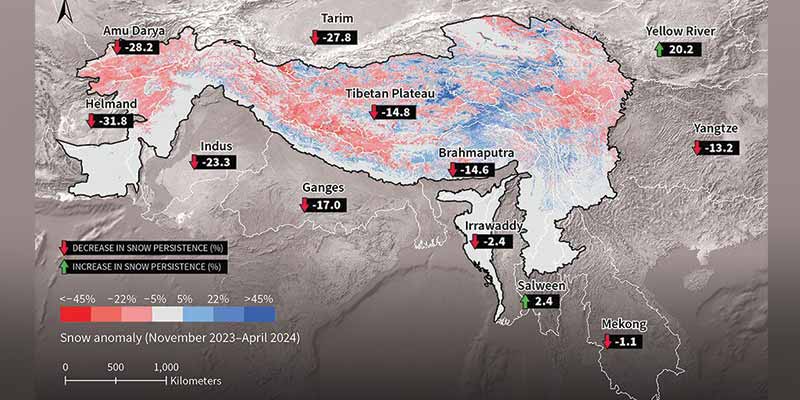- India
- Jun 20
- Kevin Savio Antony
Key findings of 2024 Hindu Kush Himalayas snow update
• In 2024, the International Centre for Integrated Mountain Development (ICIMOD) reported that the Ganga river basin, India’s largest, faced an unprecedented decline in snow cover duration.
• This reduction also impacted the Brahmaputra and Indus river basins, posing significant threats to water availability for millions in the region.
• This situation highlights profound challenges in one of the world’s most densely populated areas.
Key findings of ICIMOD Report:
• Historic Low Snow Persistence: The Ganga river basin in India experienced its lowest snow persistence in 22 years, significantly below the long-term average. Similar declines were noted in the Brahmaputra and Indus river basins.
• Impact on Water Availability: The reduced snow persistence poses a serious threat to water availability for millions of people dependent on these river basins. Snowmelt contributes a substantial portion of water to major rivers like the Ganga, Brahmaputra, and Indus.
• Regional Variability: While some areas saw record low snow persistence, others, like parts of China’s Yellow River basin, experienced higher than normal snow persistence, influenced by local weather patterns such as the East Asian winter monsoon.
• Climate Change Acceleration: The report underscores that changing climate patterns, exacerbated by global warming, are increasingly destabilising snowfall patterns in the HKH region. This includes disruptions in winter precipitation due to altered weather systems linked to high sea-surface temperatures.
• Long-term Implications: Experts warn of lasting impacts on water resources if snowfall continues to decrease, particularly in critical basins like the Indus, affecting both water availability and agriculture in downstream regions.
• Recommendations for Adaptation: The report suggests measures such as reforestation, improved weather forecasting, and early warning systems to mitigate water stress. It also emphasizes the importance of local community involvement and regional cooperation for sustainable water management.
What is the Hindu Kush Himalaya?
• The Hindu Kush Himalayan (HKH) region stretches over 3,500 kilometers across eight countries: Afghanistan, Bangladesh, Bhutan, China, India, Nepal, Myanmar, and Pakistan.
• It contains one of the largest volumes of ice and snow outside of the Arctic and Antarctica.
• The HKH region hosts four of the world’s 36 global biodiversity hotspots: the Himalaya, Indo-Burma, Mountains of Southwest China, and Mountains of Central Asia.
Known as the “Water Tower of Asia”, the HKH region is the source of at least 12 major rivers that flow across Asia:
• The Indus, Ganga, and Brahmaputra rivers flow towards the Arabian Sea and Bay of Bengal.
• The Syr Darya and Amu Darya rivers historically flowed towards the Aral Sea.
• The Tarim river flows towards the Taklamakan Desert.
• The Yellow River flows towards the Gulf of Bohai.
• The Yangtze river flows towards the East China Sea.
• The Mekong river flows towards the South China Sea.
• The Chindwin, Salween, and Irrawaddy rivers flow towards the Andaman Sea.
(The author is a trainer for Civil Services aspirants.)

